That’s Classified: Exposing Silver Bullet Technology

Abstract: Aerospace trade publications, visual reports and personal interviews with test pilots and engineers confirm the existence of multiple highly classified aerospace vehicles. These include boomerangs, black triangles, diamonds, arrowheads, and Spaceplanes/Trans Atmospheric Vehicles (TAVs). Funded by the so-called “black budget,” many of these programs are exempt from congressional oversight and public scrutiny. Developed along the famous “aerospace alley” region of southern California, many of these USAPs represent America’s super-secret “ace in the hole,” and provide a unique “power projection” capability for multiple military and intelligence agencies. Companies such as Lockheed, Rockwell, Northrop, McDonnell Douglas and Boeing made tremendous advancements during the “Reagan build-up” era, and many of these programs have now passed their “sunset” duration of deployment. Therefore, it’s now time for a re-examination of these programs and a renewed push for the “dis-lodging” of those that can be declassified without representing any threat to the national security of the United States.
Blackstar: The two-stage-to-orbit Spaceplane
During the 1980s, Soviet-era aerospace companies developed plans for what they called a “space fighter.” The primary roles for this spaceplane concept were the following: military reconnaissance, satellite interception, space station defense, and crew transfer applications. This full-scale development program fell under the jurisdiction of what came to be known as the Russian Kosmolyot I and II project. Upon getting word of these advancements in Russian aerospace technology, White House, and Pentagon officials became “deeply concerned” that America would lose the advantage in developing an operational spaceplane. Therefore, on December 1, 1985, American efforts to develop a two-stage-to-orbit spaceplane appear to have shifted into high gear, and oversight command for this program was transferred from the Department of Defense to a joint venture composed of the Central Intelligence Agency and the National Reconnaissance Office (CIA/NRO). The new code-name for this project was called “COSMIC WIND,” which was later renamed “Blackstar.” Through the tremendous efforts of former Aviation Week and Space Technology editor William Scott, a clear picture of this historically significant program has now emerged.
Approximately one month after the official go-ahead for this program the space shuttle Challenger exploded 72 seconds after launch on January 28, 1986. Since at least 70% of all payloads associated with the NASA shuttle program were classified DOD/intelligence agency applications, the Department of Defense/CIA/NRO lost what it termed its “assured access to space.” Not wanting to interrupt their schedule of launching highly classified satellites, the United States Air Force, CIA and the National Reconnaissance Office were now forced to rely on Titan booster rockets. However, there were multiple Titan rocket failures during the mid-1986 time-frame, and the “spook groups” found themselves “out of business.” The loss of these two space assets provided further emphasis and urgency for America to accelerate its plans to develop an operational spaceplane.
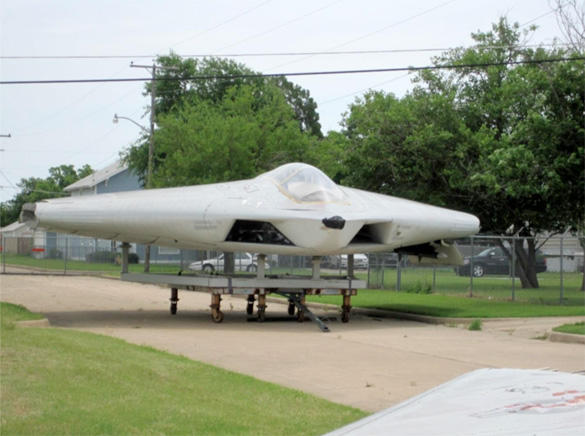
Frantic to maintain its control of the “high ground,” a desperate call went out to various aerospace defense contractors who could quickly design, build and test fly a two-stage-to-orbit spaceplane system. These included Lockheed, Rockwell, McDonnell Douglas, and Boeing. A significant majority of these contractors (except for Boeing in Seattle) had locations within what has been termed “aerospace alley” which extends from San Diego, north to Los Angeles, continuing to Lancaster/Palmdale/Air Force Plant 42, and concluding at Edwards AFB. As with most “Unacknowledged Special Access Programs” (USAPs), funding for the Blackstar program was covertly spread out over multiple projects including the ill-fated US Navy A-12 Avenger II, and the X-30 NASP (National Aerospace Plane). This wouldn’t be the first time that highly compartmented so-called “black” programs were used as a “sacrificial lamb” to cover the funding of even more highly classified projects. Many of these super-secret programs are referred to in the military/intelligence agencies as: “ace in the hole” or “trump card” technology. They are also referred to as “silver bullets.” Under extreme pressure, and on a tight schedule, the Lockheed Company in Burbank may have taken the leading role in designing a small spaceplane, and “farmed out” much of the construction/manufacturing to McDonnell Douglas in St. Louis.
The “Blackstar” system consisted of two separate components which operated as a single integrated unit: 1) a large “mothership” or carrier aircraft measuring approximately 200 feet in length. 2) a smaller “parasitic” aircraft/orbiter which could fit conformally under the belly of the mothership, and air-dropped at altitudes up to 90,000 feet. Flight testing of the Blackstar program appears to have started in 1989, and by October of the same year, the Blackstar program had flown its first operational mission. Four large carrier “Mothership” aircraft may have been produced, with eight spaceplane/orbiters possibly being built. The program was based out of Area 51/Groom Lake, utilizing the “old CIA A-12 hangers”, including and two new massive hangers that were three times larger than their historic neighbors. During flight testing and operational missions, ground controllers at Groom Lake carried the call sign “EARTH” when communicating with the spaceplane. Other bases of operation may include Alaska or Patrick AFB in Florida.
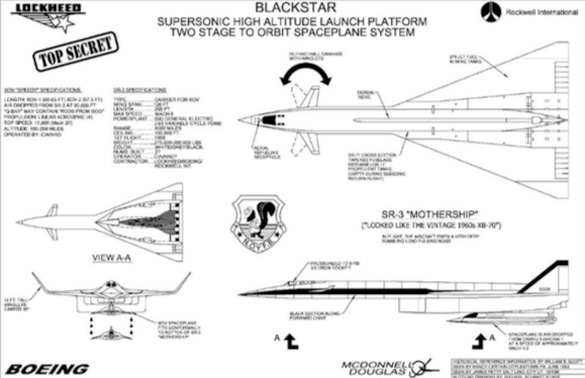
The massive mothership was referred to the “SR-3”, aka “elegant lady,” while the smaller spaceplane was designated “XOV” (Experimental Orbital Vehicle) or “Speedy.” Early in the program under the “COSMIC WIND” code-name, the large carrier aircraft was referred to as the “MAV” (Manned Aerial Vehicle), while the smaller spaceplane was designated the “AAV” (Advanced Aerial Vehicle). Resembling the 1960’s era North American Aviation XB-70 Valkyrie, the SR-3 was certainly an imposing sight to behold. Eyewitnesses who were fortunate enough to see this aircraft during the daytime described it as being “huge” or “giant.” Others simply called it the “Super Valkyrie.” Indeed, as reported by at least two former North American Aviation test pilots, the technology existed in the 1950s to develop a two-stage-to-orbit spaceplane system. With the advantage of 30 years of additional technological developments, and almost unlimited access to black budget funding, its well within the capability of the America aerospace industry to design, build and test fly such a vehicle.
With a wingspan of 120 feet, the SR-3 featured a triangular/delta wing configuration, with large “tip-sails” or winglets that rose up 12 feet and were canted at a 35-degree angle. It also featured a dorsal ridge or “spine” that extended immediately behind the cockpit, and ran down the length of the fuselage to the trailing edge of the wing. A retractable set canards (with their own winglets) were also located just aft of the crew compartment (reference email to Michael Schratt from Nancy Certain 9/13/16). These canards had the capability of retracting forward to support low speed applications. The SR-3 carried a crew of three consisting of the pilot, co-pilot and launch control officer (LRO) who sat facing backwards. The bottom of the aircraft featured a large XB-70 like triangular “splitter” air-intake which was divided into two banks at the rear of the craft. However, the most prominent feature was what appeared to be a “relieved section” or “scooped out” portion of the bottom which was designed to allow the smaller spaceplane to fit inside forming an aerodynamically efficient mating of the two aircraft (reference detailed report from James Petty to Michael Schratt 12/5/16).

According to eyewitness and Rocket scientist James Petty who saw both the Mothership and its smaller parasitic aircraft flying over Salt Lake City Utah on October 4, 1998, the more massive SR-3 carrier aircraft is powered by six modified variable-cycle J-93 engines (reference in-person 90- minute videotape interview of James Petty conducted by Michael Schratt 3/12/16). However, there appears to be a discrepancy regarding precisely what type of propulsion system was used to power the mothership. Those within the vicinity of SR-3 flight operations described hearing a VERY LOUD PULSING ROARING noise during take-off roll and climb out. This was confirmed by witness Nancy Certain Ph.D., from Doylestown PA, who saw the massive carrier aircraft during the day from a half-mile distance at an altitude of approximately 2,500 feet in 1993. Others stated that as the aircraft accelerated and gained altitude, the frequency and intensity of the pulsing noise increased. This may indicate the use of a combined cycle scramjet engine which can operate at both low and high speeds. Either way, it’s clear that this aircraft utilizes some form of “multi-cycle” engine.
The mothership has a weight of 275,000 to 300,000 pounds and a range of 6,000 miles (unlimited with aerial refueling). The SR-3 is capable of speeds over Mach 6 and can climb to an altitude of 150,000 feet. It features a white/grey exterior surface, with two being built by 1988. Fuel for the SR-3 consists of liquid hydrogen/liquid methane with JP8 used in the case of the J-93 engines. The contractors involved with designing and building the SR-3 mothership may have consisted of Lockheed, Rockwell, and Boeing. Final assembly took place at Boeing’s large assembly facility in Seattle. It’s interesting to note that on October 14, 1986, Boeing filed a patent (4,802,639) for a two-stage-to-orbit spaceplane system that closely matched the Blackstar operational capabilities, although the physical characteristics of the craft were different than what was reported by multiple eyewitnesses.Once reaching an altitude of 90,000 feet and a speed of Mach 3, the SR-3 air-drops its smaller parasitic aircraft, and either returns to its original base of operation or takes on additional fuel for an extended mission.
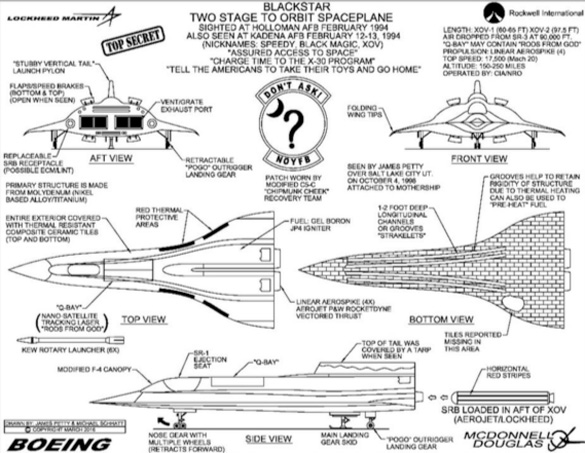

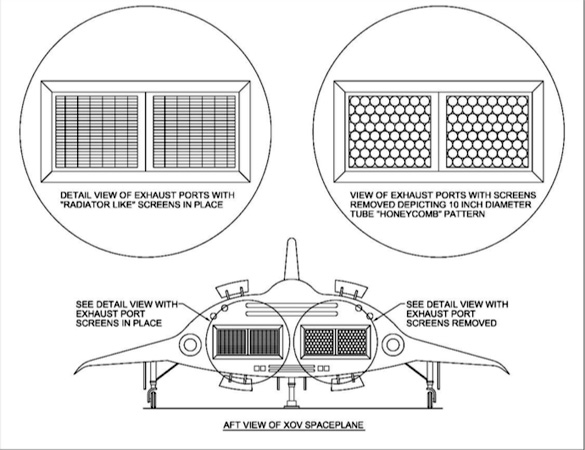
The smaller XOV/Speedy spaceplane was manufactured in two sizes and featured a highly swept wing lifting body configuration. One measuring approximately 60-65 feet in length, with a crew of two that sat side-by-side, and another measuring 97.5 feet with a single pilot. These were named “XOV-1” and “XOV-2.” Flying in an inverted low earth orbit orientation, the XOV featured a two-door “Q-bay” on its upper surface for the operation of a large aperture adaptive optics system that featured “inches resolution.” This “reconnaissance package” had the capability of correcting for atmospheric disturbances, thereby generating extremely high-resolution images of ground-based targets. The Q-bay could also serve as a launching platform for hyper-velocity depleted uranium “Rods-from God.” The XOV could attain altitudes of between 150-250 miles, and speeds exceeding 17,500 mph (Mach 20). The primary propulsion system for the XOV were four linear aerospike engines that were grouped in two banks at the aft end of the vehicle. These engines were developed by a joint venture which included Aerojet and the Pratt & Whitney/Rocketdyne Company, which later became Aerojet Rocketdyne. Witnesses who have observed the back of this vehicle described seeing what looked like “radiator screens” covering the exhaust ports. Others described it as looking like “ventilation grating.” Embedded within the exhaust ports were multiple 10-inch diameter “tubes” which served to mix cooling air, thereby reducing the vehicle’s infrared signature. These tubes gave the exhaust ports an unusual “honeycomb” appearance. Ground tests of this unique engine took place at Groom Lake during 1988.
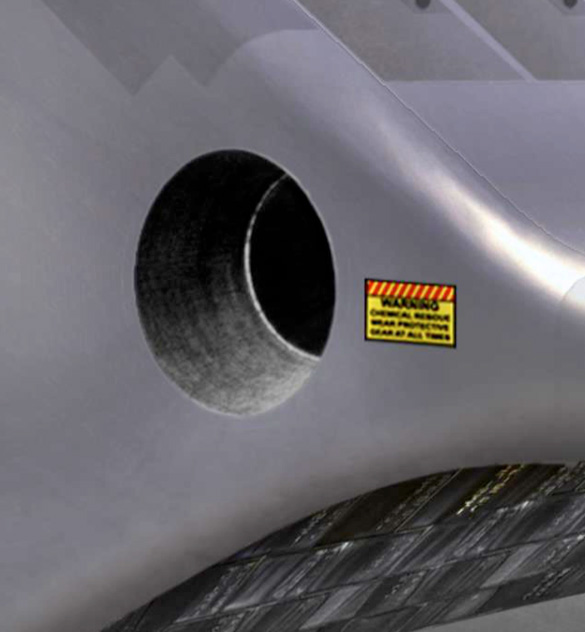
The larger 97.5-foot long spaceplane also featured articulating intakes and variable geometry exhaust ports. On either side of the exhaust ports, a dark circular opening was seen which may have served as a solid rocket booster (SRB) receptacle. These could be loaded into the craft “like a shotgun shell” and then removed after the conclusion of a mission. The SRBs served to provide an extra boost, pushing the spaceplane into a low earth orbit flight path. Once in orbit, the spaceplane had the capability of “dipping back down” into the atmosphere and then climbing back up again. Using this technique of “skipping” over the outer reaches of the atmosphere, the spaceplane could dramatically increase its range. After completing its mission, the spaceplane would glide back to earth “like the space shuttle” and land horizontally at multiple military locations in the United States.It could then be “turned around” within 48 hours or “every other day” to fly another mission. Compared to the space shuttle which can take months or even years to prepare for flight, the Blackstar system represented a cost-effective alternative. Another unique advantage was its capability to serve as a “rapid response” military/reconnaissance platform that could surprise an enemy by flying unpredictable flight paths, unlike spy satellites.
The outer wing sections of the XOV featured a “droop down” articulated capability, which took advantage of “compression lift.” The only movable control surfaces on the Speedy spaceplane were what appeared to be flaps/speed brakes located on the upper and lower rear surface of the vehicle. A short “stubby tail” which extended from aft of the Q-bay to the extreme end of the craft served as both a vertical stabilizer and an attachment point for joining with the larger carrier aircraft. The outer structure of the craft may have been built at the McDonnell Douglas facility in St. Louis and featured an advanced composite material that was “stacked” in layers forming a sandwich to attain the desired thickness. Red colored thermal protective areas were located along the leading edges of its wings. The entire bottom surface featured dark-colored thermal resistant “space shuttle tiles.” Four “channels” or “strakelets” were seen on the bottom of the craft. These one to two-foot deep longitudinal “grooves” helped to maintain the rigidity of the structure and may have served as a way to dissipate heat during high-speed operations. Apparently, these grooves/inlets were “very complex,” and most likely took multiple attempts to perfect.

The XOV incorporated a very unusual landing gear configuration which included a four-wheel nose gear arrangement, and a retractable “ski-like” landing gear skid that extended directly from the bottom of the craft. Approximately at the mid-point on the lower surface of the wings, a retractable “pogo-type” outrigger landing gear helped to stabilize the craft during roll-out. Generally speaking, highly swept low aspect ratio lifting body configurations have high landing speeds. Therefore, the Speedy spaceplane was said to have a landing speed between 250-300 mph, with the central retractable landing skid taking the brunt of the force. Certainly, the craft was a “handful” for even the most experienced test pilots. Only those with practical application in flying multiple different types of aircraft would qualify for handling such a strange and exotic aircraft. Pilots who were the “Maverick” type, and had previous air racing experience would be at the top of the list. Fuel for the XOV was a “gelled Boron” based “slurry” or endothermic type that had the consistency of toothpaste. Work on the spaceplane proceeded slowly until 1989 when the program made tremendous progress, and engineers were working “around the clock” 24 hours a day, seven days per week, for three years. It was also during this timeframe that a “fuel breakthrough” was made, which further accelerated the program.
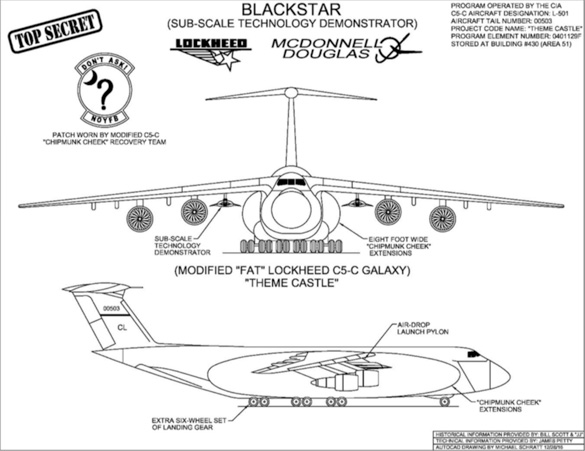
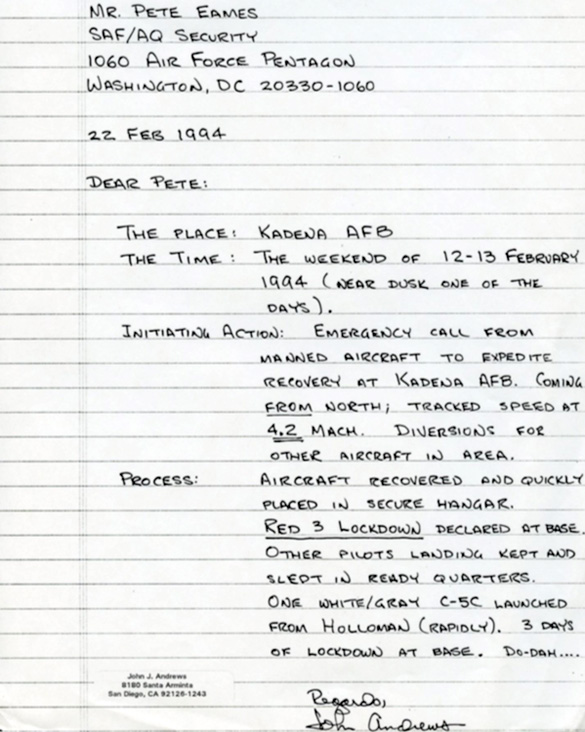
On February 13 of 1994, things took a drastic turn on the project. On that day, an XOV spaceplane was involved in an incident that resulted in the craft making an emergency landing at Kadena AFB in Japan. This particular aircraft was tracked by Kadena air traffic controllers going Mach 4.2, and other aircraft in the vicinity had to be diverted to avoid a collision. Subsequently, the entire base was put on a “Red 3” lockdown for three days. Apparently, during the launch sequence, the stubby vertical fin/pylon on the spaceplane somehow made contact with its carrier aircraft and was forced to make an unscheduled detour. Within 24 hours, a highly modified Lockheed C-5 Galaxy cargo transport aircraft was dispatched from Holloman AFB to retrieve the damaged spaceplane. To “fill a gap” in their intelligence gathering capability, the CIA/NRO convinced Congress in May of 1994 to allocate 100 million dollars to put the SR-71 Blackbird spy-plane back into service so that the Blackstar program could get back on track. Three of these unique C-5 aircraft were produced which featured eight-foot-wide “chipmunk cheek” extensions on each side of the fuselage. Originally, these modifications were specifically incorporated for the purpose of transporting large containers which protected satellites during transit to launch sites. However, they were also later used to transport classified aircraft to multiple locations around the world. These highly modified aircraft also utilized an extra set of six-wheeled landing gear. Two of these aircraft were operated by NASA and carried the tail numbers 00503, and 00504. The third was operated by the CIA and featured a large red “CL” marking on its vertical stabilizer. Upon arriving at Kadena AFB, the damaged aircraft was quickly loaded inside the C-5, which then made a direct flight back to Holloman AFB.
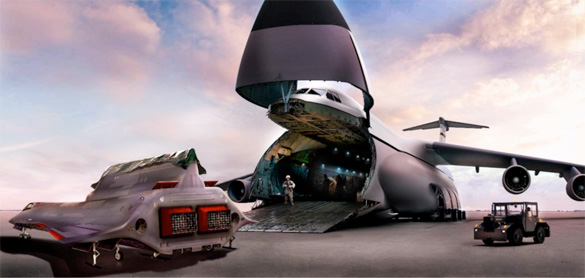
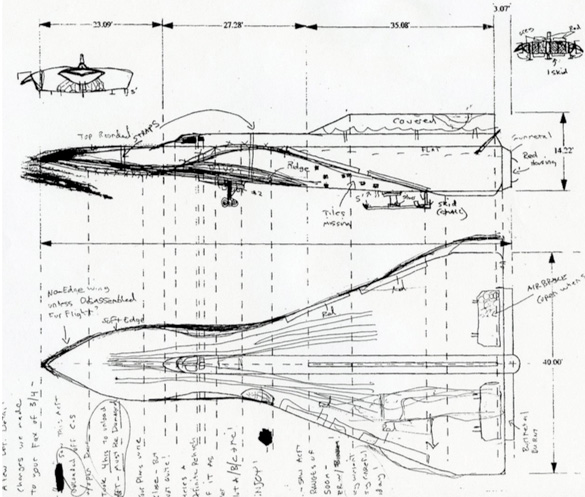
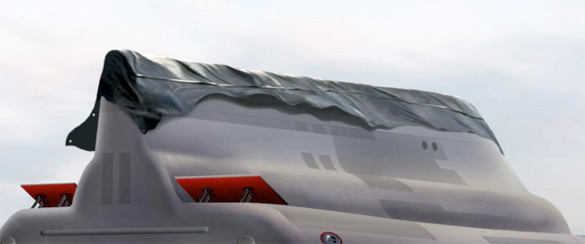
Sometime around February 15 of 1994, the C-5 arrived back at Holloman AFB with its precious yet damaged cargo inside. The aircraft then taxied to a remote part of the long runway at the base. Eyewitnesses who saw the spaceplane being unloaded from the much larger cargo aircraft during the daytime indicated that it was a complicated process which took at least three hours to complete. Apparently, the outer wing panels of the spaceplane have the capability of folding to allow for transportation in the C-5. One witness (a transient F-15 pilot), who saw the entire event unfold through binoculars from the cockpit of his aircraft while it was parked on the ground, sketched what he observed. “no-nonsense” military security guards were overseeing the entire unloading process. Once the spaceplane was pulled from the opened “clamshell” door of the C-5, it was immediately apparent that some damage had occurred to the spaceplane. A large tarp was seen covering the stubby vertical tail. However, this tarp did not completely obscure the view of the aft section which revealed a large “chunk” missing. In addition, the F-15 pilot also identified multiple missing tiles on the spacecraft’s bottom right wing section. It’s unknown at this time if this event in conjunction with other technical challenges “shelved” the Blackstar project, or if it secretly continued its covert activity. In the end, the Blackstar program represents one of the “crown jewels” of the military-industrial complex. It’s unlikely that the engineers or test pilots associated with the project will get the credit they deserve anytime in the foreseeable future. Like many other black programs, it’s entirely possible that it will remain another unacknowledged “silver bullet” being hidden away in some dark and mysterious hangar located somewhere in the southwest.
Triangles:
Special Note: The following report originated via the personal collection of UFO researcher and author David Marler. It has been reproduced for this report exactly as it appeared in the original text. Emphasis in certain areas is strictly mine.
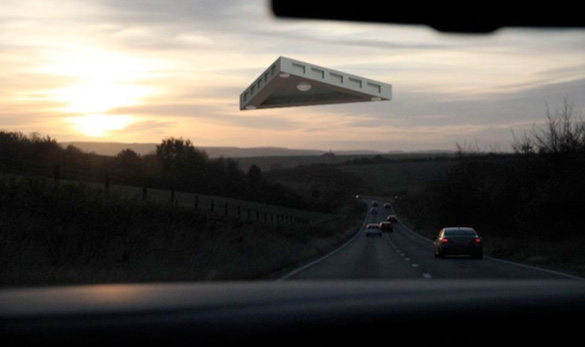
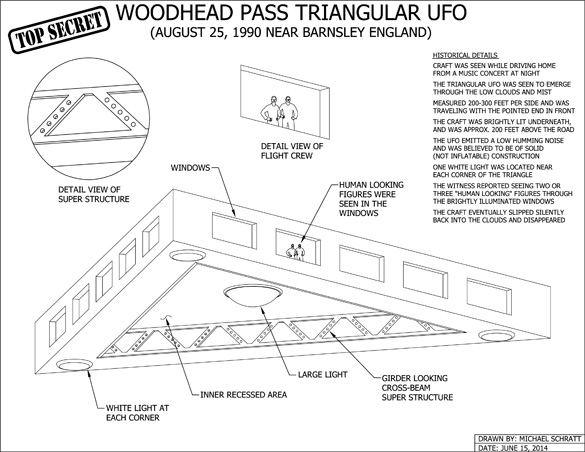
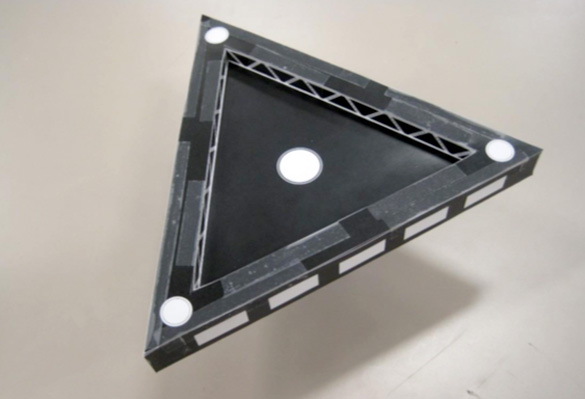
Dear Mr. Marler,
I have just read your book “Triangular UFOs an estimate of the situation.” I found the book to be most informative since I myself had a close sighting of a triangular UFO in 1990. I always assumed that what I saw was a top-secret military aircraft, and over the years I have read about such projects as the TR-3B (TR-3B real or fictitious who knows?) At any rate, I was quite happy with my assumptions until I read your book which revealed that such craft were seen as far back as the 1930’s and even in the late 1800’s. Obviously, I found this to be quite thought provoking and as led me to re-assess what I saw that night. I therefore decided to send you this e-mail outlining the events of that night, and would appreciate any comments from your perspective. Please keep in mind, it is now 23 years since my sighting, and some of the detail is by now a little fuzzy. I have therefore left out anything of which I am not certain. I have also attempted to attach what I know to be a poorly drawn sketch (it goes without saying I’m no artist). Also, I would add that at the time a serving Police Officer, and have since retired after 30 years of service.
On the evening of August 25, 1990 my then wife and I had attended at Manchester Main Road football stadium to watch the band Fleetwood Mac. At the end of the concert, it took some time to get out of the makeshift car park, and through the heavy traffic, the time was around midnight. Our route home to Barnsley took us over the Woodhead pass, which crosses over the Pennine hills, and is surrounded in the main by open moor land. That particular night, stretches of the road were covered with low cloud or mist causing poor visibility. As a result, I was forced to drive slowly, approximately 20 mph. Due to the late hour, the road was quiet, and my wife had wound back her seat and fallen asleep. I cannot say exactly where the sighting took place due to the poor visibility, but I believe I was nearer to the Barnsley end of the Woodhead Pass, possibly around the Board Hill area.
Whilst driving slowly, and trying to concentrate on the road, my attention was drawn skywards due to intermittent flashes of light which I assumed to be sheet lightning (though there was no accompanying sounds of thunder). It was whilst glancing skywards that I saw the nose of a huge black triangular craft push through the low cloud and mist. As the craft emerged further, I could see it was approximately 200-300 feet in length and width at its widest part. It travelled pointed end first, and was well illuminated around its undercarriage. The craft was moving at a speed of around 10 mph, and was approximately 200 feet above the road. On seeing the craft, I wound down my car window, but could hear only a very low (almost imperceptible) humming sound. I could see that the craft was of a solid construction (not inflatable). This fact, the slow speed, and quietness gave the craft an eerie impression. I have little knowledge of aerodynamics, but even I knew that conventionally something so big and solid should be traveling at hundreds of miles an hour in order to stay aloft. (Therefore, to my mind, it was somehow defying gravity).
As previously stated the undercarriage was well illuminated with a large white light at each corner, and a light in the center. The undercarriage also appeared recessed, and I could see some sort of superstructure. As the craft passed above, I slowed the car to a virtual stop, and leaned out of the driver’s side window. The side of the craft appeared to have several illuminated windows, and at one of the windows I saw two to three figures that appeared to be human. (Certainly nothing about the figures made me think they were anything other than human, reinforcing my belief that the craft was a military project). I could see one of the figures either pointing or waving in my direction. Whilst watching the craft, it slowly and silently slipped back into the low cloud and disappeared. At this stage I drove off the road and climbed out of my car, but could see and hear nothing. By now my wife was awake, but too late to see the craft. I observed the craft for approximately 30 seconds which does not sound long, but believe me it was. I submit my story for your information, and would welcome any insight or comment from yourself. For obvious reasons, I do not make my story common knowledge, and I would be grateful if you kept my details private.
Regards, GS
Barnsley England
(name withheld by request of the primary witness)

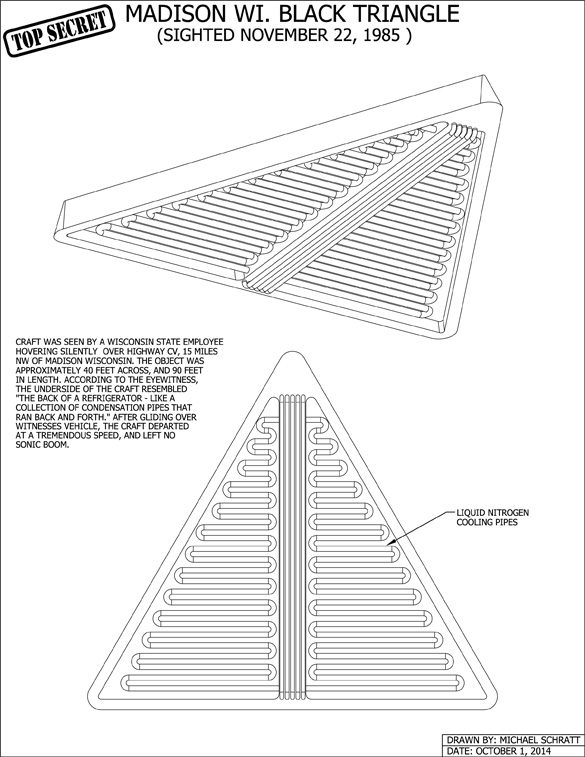
The question all of us need to be asking here is would extraterrestrials by flying around in our atmosphere using triangular shaped craft with “tubes and pipes” on their bottom surfaces? It’s interesting to note that during the Hudson Valley Boomerang wave (1982-1989), many eyewitnesses reported seeing “huge metallic beams” on the underside of the craft. Others reported seeing “metal type work, like cross-beams, and tubular things hanging down here and there.” A similar looking mechanical under-structure featuring “tubes and pipes” was also identified on the bottom surface of the triangular shaped craft during the Belgium wave of 1989-1990.
In addition, during the January 5, 2000, southern Illinois triangle sightings, Shiloh police officer David Martin described seeing what he called “building blocks” and “plumbing pipes” on the bottom of the craft that he observed. What on earth could these pipes be used for? What is their exact function? One possible explanation could be that they are being utilized as liquid nitrogen cooling pipes to chill a super-conductor or liquid mercury plasma. These pipes would be used to cool the central “core” of the craft, which may explain the “donut shaped” or circular opening seen by multiple eyewitnesses. In fact, it appears that due to their placement, these pipes not only cool the central portion of these vehicles but the entire craft itself as one fully integrated unit. It seems clear that the material used to manufacture these triangular shaped craft is truly of an exotic nature. This is because materials must be in an extremely low energy state (very cold) to become “superconductive.” Of course, this requires a tremendous amount of energy or electrical power to achieve, which may explain the low frequency “humming” sound heard by multiple eyewitnesses in the vicinity of these craft. The cryogenic equipment associated with these objects produce extremely powerful electromagnetic fields around the craft which may explain the reports of strange effects such as radio static, and automobile engines mysteriously turning off and coming back on when the craft departs.
Are we hearing the effects of an electrical transformer associated with these vehicles? Multiple reports from Belgium, New York, Connecticut and Southern Illinois indicate that these triangular shaped objects fly/float/hover virtually silently, but in many cases, emit a sound similar to a “sewing machine,” or a “machine shop running in the distance.” Has the American aerospace industry finally achieved the “Holy Grail” of aviation by constructing triangular shaped craft that utilize an onboard power source (possibly a nuclear reactor), in conjunction with high voltage electrical transformers which supply the necessary power to chill the core of a superconductor? These craft would lack the wings, propellers, jet engines, and control surfaces of standard aircraft, and could mimic the form fit and function of “extraterrestrial UFOs.”
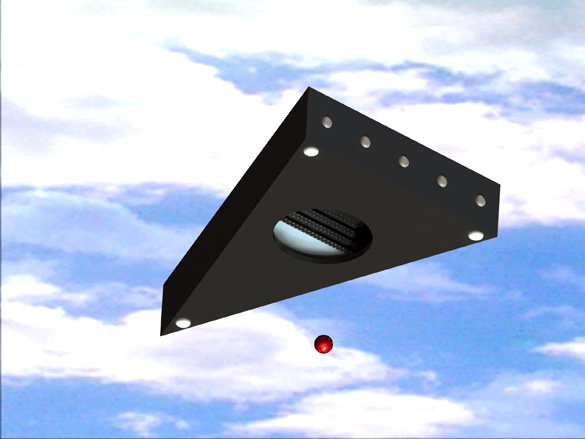


It was November of 1985 when Yorktown Heights NY resident Maureen Davis had a genuinely incredible night-time encounter with a massive shaped triangular object which was described as being the size of a “football stadium.” She had been parked at the intersection of Route 132 and Oakside Road waiting for her husband to get off the bus. Then, Maureen noticed something strange in the sky towards the northeast. It appeared to be a massive isosceles triangular-shaped “thing” that was hovering silently near what seemed to be the Lake Osceola area. To her amazement, the bottom of the craft opened up, and she got a very rare glimpse of the interior. She described seeing multiple levels of lights on the inside (similar to a multi-story terrace-shaped apartment complex). After approximately three minutes, a pulsating red light flew up into the opening, and the circular “hatch” disappeared. The strange triangular shaped object then appeared to speed away at incredible speed, without causing a sonic boom. (Reference In The Night Sky Page 38 by Linda Zimmermann). So, what did Maureen Davis see? Was it an extraterrestrial spacecraft from another world? Or, was it something that had a more “earthly” explanation? Let’s examine one feature of this encounter. Specifically, the craft’s departure. Many times, in UFO cases, we hear of the craft departing like a “spark off of a grinding wheel.” In other cases, we read of UFOs accelerating with “fantastic speed”, without generating a sonic boom. Could there be a “down to earth explanation” to these flight characteristics? As an aircraft reaches supersonic speeds, it creates shock waves, and a tremendous amount of aerodynamic heat builds up on its surface. To combat this heating, the space shuttle orbiter uses thermal resistant tiles throughout its entire airframe. However, this approach could only be considered a “band-aid” fix at best. In 1967, the Norair Division of Northrop began experimenting with highly charged electrostatic fields on a metal test probe. The results of these studies concluded that an aircraft’s “sonic boom footprint” and could be significantly reduced or eliminated entirely. They also discovered that the problems associated with supersonic heating could also be drastically lowered. Obviously, these breakthroughs could have potentially incredible military applications to advanced aircraft. Now, factor in the billions of dollars spent each year on classified “black” programs, and its entirely within the capability of the American aerospace industry to design built and fly aircraft that could be mistaken for “extraterrestrial” UFOs. Ref: AIAA (American Institute of Aeronautics and Astronautics Technical Paper No. 68-24 published January 23, 1968)

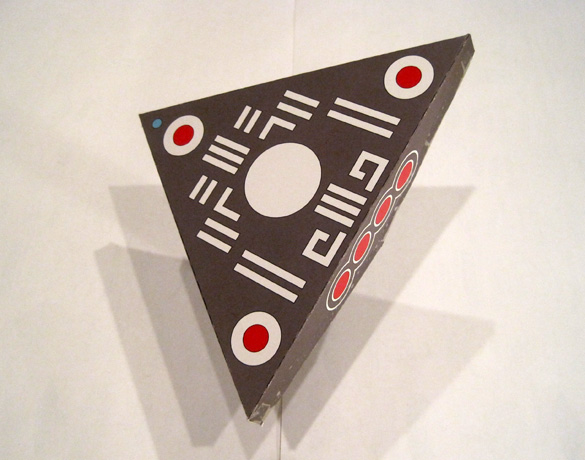
It was March 31, 1999, when Colin Saunders and three others were driving along the Old Fosse Way near the village of Monks Kirby when they noticed a group of lights off to the left that was approximately 200 feet in the air. As they got closer, they could see four red light that were at an angle of about 30 degrees. Incredibly, a diamond shaped outline seemed to appear around the lights. At this point, the strange craft tipped up vertically “like an airship or submarine” in slow motion as though it were underwater. By now, the craft had fully materialized into a triangular shape. The surface of the craft appeared to have a dark grey liquid mercury appearance that “rippled” up and down its surface. However, the most interesting feature of the unknown object were multiple “raised box-like sections” that extruded from the top. Mr. Saunders never got a look at the bottom of the vehicle but noticed the identical “box-like” pattern on the bottom of a sketch drawn by one eyewitness of a triangle that was seen in Belgium during 1993. He surmised that this might have been the same or similar series of craft. Could these unique features be part of a “heat sink” or cooling apparatus similar to the mechanical “tubes, pipes and cylinders” which were seen on the bottom of the Belgium triangle between 1989-1990? (Source: Triangular Perspectives by Colin Saunders)
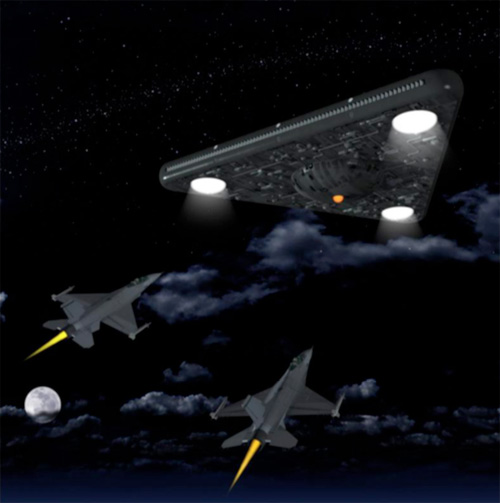
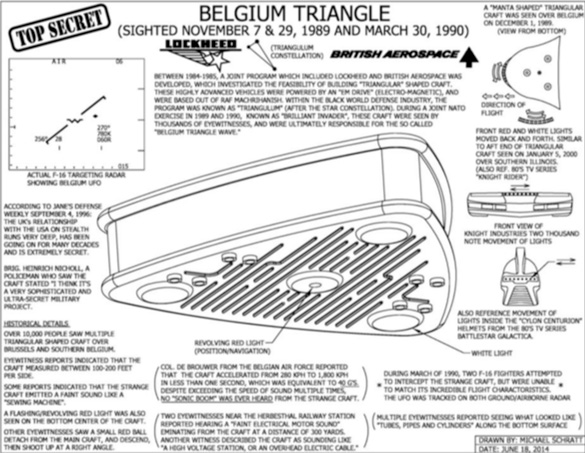
Starting in November of 1989, thousands of eyewitnesses in Belgium began seeing triangular shaped UFOs that appeared to hover over the town of Eupen. These witnesses included multiple gendarmes (national police). The triangular craft were described as being “as big as a football field,” and having a bright spotlight at each corner, with an amber colored light in the center. The UFOs were reported to be flying slowly silently over rooftops, and beaming high-intensity searchlights onto the ground. Later, on March 30, 1990, two Belgian F-16s were scrambled to intercept the unknown aircraft. The object was confirmed to be a “hard target” by at least three ground-based radar stations, and two onboard radars within the fighter aircraft which came within 12 miles of the UFO. According to a military official, these UFOs “exceeded the limits of conventional aviation.” In a highly publicized press conference, Belgian Air Force Col. Wilfred De Brouwer stated that the UFO dived from 10,000 to 4,000 feet in two seconds (equivalent to 40 G’s), and accelerated from 600 to 1,100 mph at the same time. The bottom surface of the craft appeared to have a very mechanical looking configuration which included tubes, pipes, cylinders and crisscross effects. As mentioned earlier in this report, these may be associated with the cooling of a superconductor or rotating plasma. Could this have been an extraterrestrial spacecraft? According to a police officer (Brig. Heinrich Nicholl) who saw the craft over Eupen, he assessed that the craft was a “very sophisticated and ultra-secret military project.” Students of this line research will recall the comments of the late Ben Rich who stated in 1995 that “we have things out in the desert that are 50 years beyond what you can comprehend.” Obviously well within the time-frame of the Belgium Triangle sightings of 1989- 1990. (Ref: Associated Press Report 7/12/1990, New York Tribune 11/15/1990, Wall Street Journal 10/10/1990)


The following short note was sent to the Center for UFO Studies and addressed to Dr. J. Allen Hynek almost two decades after he passed on April 27, 1986. It has been reproduced in this report for the very first time.
1/17/05
Mr. Hynek,
Dear Sir,
I don’t know what this ship is, but I was in the Navy, and I have never in my life ever seen anything as this. The government knows more than they say they know, I’m sure. The American public knows it’s the truth, and we as a nation will keep fighting for our right to know. Some of us already know, even at Roswell and Area 51, where the truth is out there. I will never forget what I saw and heard that night. I know of someone else who saw it as well.
Yours Truly,
Respectfully submitted,
M.M.
Helena Missouri
Author’s special note: During my three-year investigation of the over 60,000 UFO cases which comprise the CUFOS (Center for UFO Studies) archives, I uncovered many incidents which included a detailed report, and a sketch drawn by the primary eyewitness. Some of these cases had been buried for up to 30 years, and have never seen the light of day. One such example dated January 17, 2005, referenced a sighting of a massive triangular UFO which was seen on March 5, 2003, at 9:50 P.M. in Helena Missouri. The witness described an encounter with a gigantic superstructure looking triangular craft that measured approximately one football field in length, and about two stories high. The sighting lasted about 10 minutes and occurred off the front porch of his house. According to the witness, as the craft flew overhead, it “made pictures fall off the living room wall, and shook the whole house.” The unusual UFO featured a large “fluorescent” light on the bottom that intermittently flashed every 15 seconds. Near the end of each corner, a bright steady light was also observed.
The entire craft appeared to be covered with a “glass frame,” which may have been some type of transparent panels. He also described a “walkway” complete with a “railing.” In addition, the primary eyewitness stressed multiple times that the craft was made of what he termed “rusty looking old bridge steel.” The structural configuration of craft appeared similar to the criss-cross bracing found on the supporting towers of the George Washington Bridge which spans the Hudson River and is located between New York and New Jersey. He also clearly described seeing “rivets from an old bridge” which appeared to be used to fasten the entire craft together. Although the witness stated the craft was “not from this world,” a careful examination of his original sketch points to an earthly origin. The crossbeam and girder construction, in conjunction with regularly spaced “rusty rivets” is clear evidence of human-made technology. In addition, the use of a “walkway,” glass frame, and flashing lights support an earthly explanation. Of particular note is the fact that a French fighter pilot over Europe also saw a similar craft exhibiting triangular superstructure on the night of November 5, 1990, as highlighted on page 290 of Timothy Good’s book: Earth, an Alien Enterprise.
Boomerangs:

Monique O’Driscoll was driving home near Kent NY on the night of February 26, 1983, when her daughter who was with her noticed some strange lights on a nearby hill. The lights appeared to be hovering, but then started moving to the east at about 15 mph. By now, Monique could discern that the lights were connected to some type wing shaped dark mass. The lights were very bright and appeared to be red, white, blue and yellow. The unknown object then moved towards the vicinity of White Pond, and Monique stepped on the accelerator to catch up with it. When they arrived at the pond which was frozen at the time, Monique stopped her vehicle and noticed through her windshield that the craft passed directly over her car. At this point, she saw that the lights on the craft appeared to be flashing in sequence up and down its “wings.” It then moved over an area of the pond about 200 feet from shore. It was hovering no more than 30 feet high, and Monique could see the brilliantly flashing lights reflecting off the frozen pond below.
She also noticed that the craft was entirely silent, and stated that she could see “the underbelly part. It’s solid. It had metal-type work, like cross-beams and tubular things hanging down here and there. I was so close I could’ve thrown a ball and hit it.” This author also uncovered a rare letter from well-known researcher and lecturer Stanton Friedman which is worth highlighting in part. “I have always been bothered by the Westchester County sightings because I never heard of actions that would label the technology alien. Wings in outer space could only be decoration, but do of course match an earthling approach.” (Source: Reporter Dispatch White Plains NY September 11, 1983, Philadelphia Inquirer September 28, 1984, Letter from Stanton Friedman to Tony Gonsalves January 17, 1990)
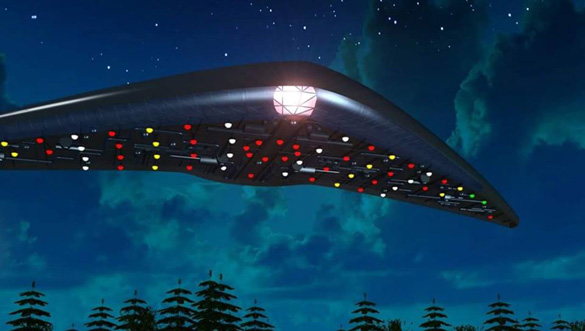
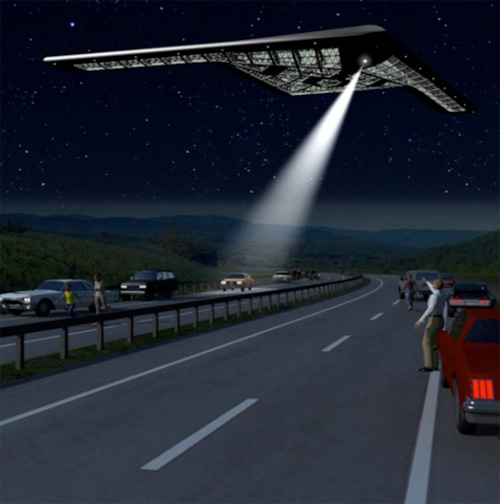

On the night of March 24, 1983, hundreds of motorists driving along the Taconic State Parkway (NY) observed a massive “V” or boomerang shaped craft. Drivers pulled off to the side of the road, slammed on their brakes, and got out of their vehicles to observed the unknown object which was hovering silently at tree-top level. The craft appeared to be making a “zig-zag” flight path as it headed north towards Yorktown Heights. Multiple witnesses described seeing a powerful white spotlight beaming down from the craft to the cars below. The mysterious craft seen making 180 degree flat turns without banking. Others who were directly below the object stated that they could see “pipes, beams or cylinders” on its lower surface. In addition, multiple witnesses reported seeing what looked like “transparent panels” revealing an interior mechanical structure resembling the crossbeam and girder construction similar to that of a truss bridge. (Source: Patent Trader Mt. Kisco NY March 25, 1983, Reporter Dispatch White Plains NY September 11, 1983, Danbury Item Port Chester NY March 26, 1983)
What did the over 25,000 eyewitnesses observe during the Hudson Valley Boomerang wave of 1982-1989? Did they see an “alien” spacecraft or something that was built by the U.S. Navy? It’s interesting to note that the March 24, 1983 sighting took place exactly 24 hours after President Ronald Reagan give his address to the nation outlining his plans for the so-called “Star Wars” or SDI (Strategic Defense Initiative). Could there be a connection? During the Reagan era (1981-1989), multiple black programs excelled and became operational. One of these could have been a mobile airborne relocatable over-the-horizon radar system which was designed to track and monitor incoming Soviet ICBMs. This system would be completely impervious to a Russian missile attack, and addresses virtually all of the flight characteristics observed by witnesses of the Hudson Valley UFO wave. It’s time for the field of Ufology to overcome its “UFO bias” and carefully examine every possible earthly explanation before concluding that a UFO is extraterrestrial in origin.





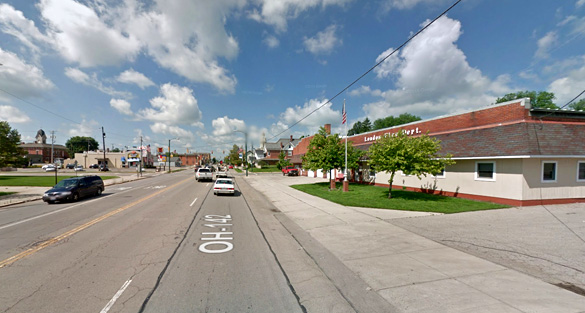
I have read a handful of UFO reports over the years where the witnesses describe the craft as looking similar to old civil war era armor plated boats, black iron, rivets, rough looking exterior, Not really what comes to mind when you think of a civilization visiting us that many be 1000s of years ahead of us, nor is it whats to be expected from any man-made experimental aircraft, I doubt this the last material they would ever choose to use…something fishy about these, not sure what it is though.
They can’t hide all this for ever, at some point an animal breaks from it’s cage, a water leak from a pipe and you can surely bet that all chaos will break loose, the shadow government
/military will need what they have for their own protection. I’ve seen many Alien craft and some of the reversed engineered craft, even had Telepathic contact from a craft I watched for 25 min. in 2011…… Been getting ready for SHTF since.
They can hide this stuff as long as they like, forever if thats what they want. have to remember these triangle craft are not a new thing, Ive read numerous very old UFO reports that the witnesses describe a big black spear tip, the popular woodcut from 1530s Nuremberg UFO event shows a big black spear looking craft. Whatever these things are, they have been coming here for a very long time, if you read thru the very old reports, its the same shapes of crafts, same behavior, same capabilities, etc. The only thing that changes is how the witnesses describe them.
Its also interesting that if these things are indeed from another civilization, then why have their craft remained the same over so long a period, based on the historical descriptions, craft seen 1500 yrs ago is pretty much like the UFOs reported today, did they plateau technologically?
We’ve been hearing about advanced US aircraft modeled after crashed alien vehicles for a long time but I doubt that any of them used liquid nitrogen, etc. to power their engines. If these stories have some truth to them, I’m sure the tech is buried under a mountain of secrecy but still, it would nice to hear some stories about how we’ve been able to make engines or drives powered by element 115, as first described by Robert Lazar. I mean, I’m not getting any younger here, I’d like to see something exotic and real before I go, kind of a bucket list thing.
Ha. You make a good point, but when it comes to element 115, don’t expect any stories anytime soon. It is actually one of the problems with Lazar’s stories. Element 115, or Moscovium, is extremely unstable and has a very short half-life. It decays in less than a second. BTW, Lazar was not the first person to talk about element 115, like so many believe. You can find papers going back at least to the 70s. It was given the temporary name Ununpentium in 1979.
Great site my friend
Idk Alejandro, I’m always a bit skeptical when someone proclaims something however I do know that you do your homework so I’m a bit more inclined to believe you. Therefore I do believe that element 115 was mentioned and probably discovered prior to lazar mentioning it. The only thing that genuinely puzzles me and I’ll wager puzzles you is how the guy seemingly hates the attention the subject matter has garnered and how there is a litany of compelling events and subsequent descriptions by lazar that are not only corroborated by knapp and other people he interviewed but surely warrant a closer look. I’m aware of the contradictions but knapp made a statement that has veracity in my estimation and that is that people in general have the propensity to embellish and I’m referring to MIT. Just a small side note, I bet James Cameron read about 115 and came up with unobtainum for his movie avatar lol. Keep up the good work!
You are right. I have a high level of respect for George Knapp, and his interest in Lazar goes a long way for me. Although many of Knapp’s third party witnesses are anonymous, Knapp’s credibility keeps me interested.
Michael Schratt – excellent article. I also saw this equilateral triangle craft SO CLOSE I could have hit it with a rock! I didn’t dare take my eyes off it. Summer 1997, St. Croix river valley – just north of Stillwater Minnesota. So it was the same size of the craft described sighted in Madison Wisconsin. So it was probably the same type of craft. I also heard the low humming noise emitted from this craft. Amazing. I too assumed it was military – and someone online saw an insignia on the bottom of this craft, and someone else recognized it precisely as from the Air Force Space Innovation Center out of Colorado. Something like that.
Dear Readers micheal schratt better give me credit for alot of the drawings he is taking credit regarding blackstar I wad the first who so them overflying salt lake my friends at my machineshop help me repruduce alot of what Mr.Shartt is taking credit for Mr. james Petty
Actually, Michael did credit you, Mr. Petty. If you search for your name you will find it several times where Michael is crediting you with the images and research.
Dear Readers I owe everybody an apology especially my dear friend
Mr.Michael S.
ThankMr.James Petty He gave me credit for drawings articles and sighting.
This actually infuriates me. Billions of OUR money spent for decades and we see no actual benefit from it. They keep it all to themselves, letting themselves benefit (while laughing at the plebes below). This makes me want to start carrying my rifle in my car at all times so if I ever see a triangle floating low in the sky I can try to damage it/bring it down, forcing disclosure and an end to the thieving secrecy.